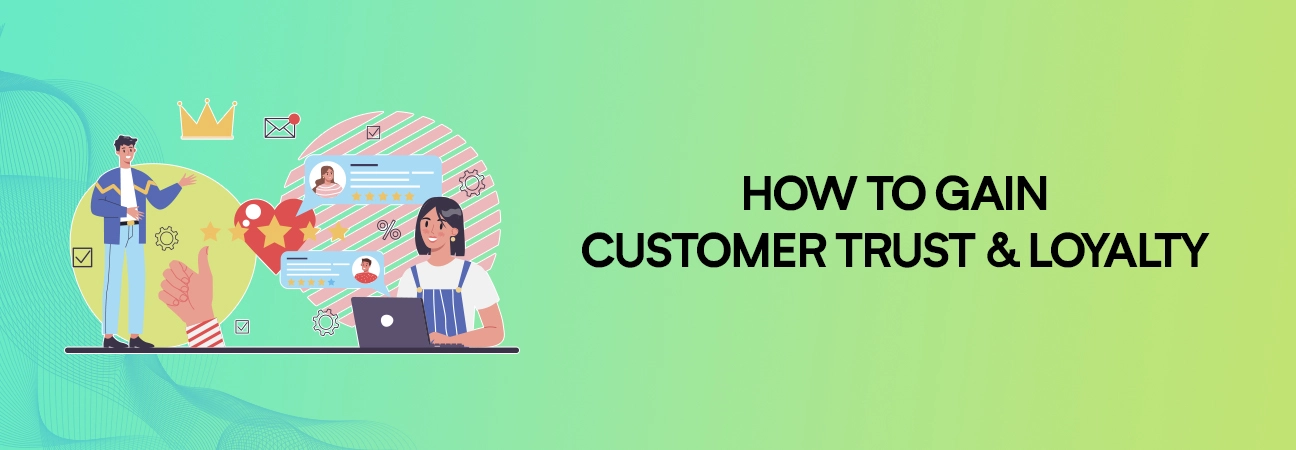
15 Effective Ways to Gain & Build Customer Trust and Loyalty for Increased Sales
Did you know that 81% of online shoppers say trust is the primary driver behind their purchase decisions?
In the vast digital landscape, building a genuine connection with your audience can feel like finding a needle in a haystack.
But, what if I told you there’s a formula to it?
In this article, you’ll learn about the intricacies of gaining customer trust and loyalty online and how to weave authenticity into your brand’s narrative to achieve lasting rapport.
Why is this so crucial? Because in an era where consumers are bombarded with choices, trust is your golden ticket to stand out.
Remember the last time you hesitated to click that “buy now” button? Let’s address those concerns.
How can you, as a brand, ensure your customers feel seen, heard, and valued? Dive in with me, as we embark on this journey of fostering trust, one digital handshake at a time.
Ready to transform your online relationships? Let’s get personal and exciting together!
Why is customer trust important for online business?

Building customer trust is a crucial part of any online business because it directly impacts your sales and your company’s reputation.
With millions of online scams every day, it’s no surprise that consumers are wary. They need reassurances that your business is legitimate and that you value their specific needs and wants.
Trust invokes confidence in your offering, giving customers the push often needed to make a purchase or engage with your business.
Without trust, potential customers may turn to your competitors, which is why it’s essential to strive for an authentic, reliable online business presence.
Why customer loyalty matters ?
Just gaining a customer’s trust is only the start. The subsequent goal is to foster customer loyalty.
Loyal customers not only create a stable income stream, but they can also become powerful promoters of your business, as they share their positive experiences with others.
Additionally, maintaining a base of loyal customers is often less expensive and more profitable than continually trying to attract new ones.
Increasing customer loyalty can translate into increased business growth, as the likelihood of repeat purchases rises, and the cost of acquiring new customers falls, resulting in improved return on investment for your marketing efforts.
How to build customer trust and loyalty online: 15 key strategies
Let’s explore the key strategies you can employ to build a strong customer base that trusts and stays loyal to your brand.
1. Offer Excellent Customer Service:

Exceptional customer service is a cornerstone of building trust in your online business.
Providing timely delivery of products and services, responding promptly to customer inquiries, offering personalized assistance, and providing post-sales support are crucial aspects of excellent customer service.
By consistently delivering exceptional service, you show your customers that their satisfaction is your top priority, which fosters trust and encourages them to continue associating with your brand.
2. Exhibit Transparency:
Transparency in your business practices is essential for building a deep level of trust. This means being clear and upfront about your prices, policies, and any changes being made.
By openly communicating and demonstrating that you have nothing to hide, you reassure your customers and inspire their loyalty.
Transparency also involves being honest about any potential limitations or challenges your products or services may have. This transparency builds credibility and trust with your customers.
3. Demonstrate Reliability:
Consistency is key when it comes to affirming that your online business is dependable.
Whether it’s consistently delivering high-quality products or meeting your declared deadlines every time, reliability fosters trust and encourages repeat patronage.
When customers can rely on your business to consistently meet their expectations, they develop a sense of confidence and trust in your brand.
4. Accumulate Reviews:
Positive reviews are powerful endorsements of your products and services.
Encourage your satisfied customers to leave reviews and showcase genuine customer feedback prominently on your website.
The social proof inherent in good reviews enhances your credibility and inspires trust.
Potential customers are more likely to trust a business that has received positive feedback from others, as it gives them confidence in the quality and reliability of your offerings.
5. Humanize Your Business:
Showing that there are real people behind your products and services can greatly enhance trust.
Share photos of your team, host live chats or videos, and highlight employee stories.
By providing a glimpse into the human side of your business, customers feel more at ease dealing with an entity they can connect with on a personal level.
This human touch builds a sense of trust and authenticity, fostering stronger customer relationships.
6. Use Respected Payment Platforms:

Payment security is a significant concern for customers engaging in online transactions.
To ease this fear and inspire confidence in your processes, ensure you offer a variety of trusted payment methods.
Partnering with respected payment platforms and displaying their logos on your website can alleviate customer concerns about the security of their financial information.
By prioritizing secure payment options, you demonstrate your commitment to protecting your customers’ sensitive data.
7. Implement Quality Guarantees:
Offering guarantees for the quality of your products or services illustrates that you stand by what you offer.
Assure your customers that if something isn’t right, you will make it right. This commitment to customer satisfaction further enhances trust as it shows that you are willing to take responsibility and rectify any issues that may arise.
By providing quality guarantees, you instill confidence in your customers that they are making a safe and risk-free purchase.
8. Drive Engagement Via Social Media:
Regular interaction and engagement through social media platforms can foster a “give-and-take” relationship with your customers.
Share behind-the-scenes content, celebrate milestones, and respond to customer messages promptly.
By actively engaging with your audience, you build a sense of transparency, accessibility, and responsiveness.
This engagement builds trust and customer loyalty as it shows that you value their input and are committed to maintaining an open line of communication.
9. Encourage Referrals:

When customers refer others to your products or services, it signifies high levels of trust and satisfaction.
Encourage and incentivize your satisfied customers to refer your business to their friends and acquaintances. Acknowledge and reward their efforts with referral programs or exclusive discounts.
By actively encouraging referrals, you promote loyal behavior and pave the way for an ever-increasing web of trusted new customers.
Referrals from satisfied customers serve as powerful endorsements and can significantly boost trust in your online business.
10. Making Product Descriptions Clear:
When it comes to purchasing products online, customers rely heavily on the information provided in product descriptions.
Clear and concise descriptions not only help customers understand what they are buying but also enable them to make informed decisions.
By providing accurate and detailed information about the product’s features, specifications, and benefits, businesses can build trust and enhance the customer’s shopping experience.
Additionally, using language that is easy to understand and avoiding jargon or technical terms helps bridge the gap between the product and the customer’s understanding.
11. Displaying Trust Badges:

Trust badges are visual representations of a company’s commitment to security, reliability, and customer satisfaction.
These badges, commonly found on websites, indicate that the business has taken the necessary measures to ensure a secure online shopping experience.
Trust badges can include certifications such as SSL (Secure Sockets Layer), payment gateway security, and customer reviews.
By prominently displaying trust badges, businesses establish trust with their customers, reassuring them that their personal information is safe and that their transactions will be secure.
12. Providing Clear Details on Return/Warranty:
One of the main concerns for customers when making online purchases is the assurance of returns and warranties.
Offering a hassle-free return policy and comprehensive warranty not only builds trust but also demonstrates the company’s commitment to customer satisfaction.
Clear details about the return process, including timeframes, conditions, and any associated costs, provide transparency and reassurance to customers.
Similarly, outlining the warranty coverage, duration, and steps for claiming it helps customers feel confident in their purchase and provides them with peace of mind.
13. Creating Content Relevant to the Audience:
In today’s era of content overload, businesses must go beyond simply promoting their products.
Creating content that is relevant to the target audience’s interests, needs, and pain points is essential for engagement and building a loyal customer base.
By conducting thorough research to understand the audience’s preferences, businesses can tailor their content strategy to address specific topics, provide valuable insights, and offer solutions.
Engaging blog posts, informative videos, and social media updates that resonate with the audience not only establish the business as an authority in the industry but also foster a sense of community and connection.
14. Connect with relevant influencers

In today’s digital landscape, connecting with influencers has become an essential strategy for businesses looking to expand their reach, build brand awareness, and engage with their target audience.
Influencers possess the power to sway consumer opinions and shape trends, making them valuable partners in any marketing campaign.
15. User-Friendly Website:
A user-friendly website is a powerful tool for enhancing user experience, driving conversions, and establishing a strong online presence.
By implementing intuitive navigation, responsive design, fast loading speeds, clear CTAs, engaging visual design, streamlined content structure, and user feedback mechanisms, you can create a website that captivates visitors and keeps them coming back for more.
Prioritize user needs, continuously test and optimize, and watch your website become a valuable asset for your business’s growth and success.
Conclusion:
In the world of online business, establishing and maintaining trust with customers is of paramount importance.
By implementing these practices — engaging on social media, encouraging referrals, providing clear product descriptions, displaying trust badges, and creating user-friendly and informative content — businesses can bolster customer confidence, encourage customer loyalty, and consequently, amplify their future success.
As we move further into the digital age, these trust-building strategies will remain vital components in the quest for sustainable growth and prosperity.
Whether you’re a seasoned professional or a budding startup, make these strategies a part of your ethos to enjoy a strong, trustworthy relationship with your ever-growing customer base.
How can you build customer trust FAQ
1. How do you build trust with your audience?
To build trust with your audience, you need to be credible, reliable, and transparent. You should also be authentic and genuinely interested in helping your audience.
Here are some specific tips:
-
Provide high-quality content and information: This shows your audience that you know what you’re talking about and that you’re committed to providing them with value.
-
Be consistent: Publish new content regularly and be responsive to your audience’s comments and questions. This shows that you’re reliable and that you care about your audience.
-
Be honest and transparent: Don’t make promises you can’t keep and be upfront about any potential drawbacks or risks. This shows your audience that you can be trusted.
-
Be yourself: People can spot a fake from a mile away, so be genuine and authentic in your interactions with your audience.
2. What are different ways to build trust and loyalty with customers?
There are many different ways to build trust and loyalty with customers. Here are a few examples:
-
Provide excellent customer service: This means being responsive to customer inquiries, resolving problems quickly and efficiently, and going the extra mile to make customers happy.
-
Offer a satisfaction guarantee: This shows customers that you’re confident in your product or service and that you’re willing to stand behind it.
-
Reward customer loyalty: Offer discounts, special promotions, or other incentives to repeat customers.
-
Make it easy for customers to do business with you: This means having a user-friendly website, offering convenient payment options, and providing clear and concise information about your products or services.
-
Personalize the customer experience. Get to know your customers and their needs, and tailor your interactions with them accordingly.
3. What is customer loyalty and trust?
Customer loyalty and trust are two key components of a successful business. Customer loyalty is when customers consistently choose to do business with a particular company. Customer trust is when customers believe that a company is honest, reliable, and has their best interests at heart.
When customers are loyal and trust a company, they are more likely to:
- Make repeat purchases
- Spend more money with the company
- Recommend the company to their friends and family
- Forgive the company for occasional mistakes
4. How do you lose customer trust?
There are a number of things that can damage customer trust, including:
-
Providing poor customer service: This includes being unresponsive to inquiries, resolving problems slowly or inefficiently, and not going the extra mile to help customers.
-
Breaking promises: This could involve promising a delivery date that you can’t meet or offering a feature that you don’t deliver on.
-
Being dishonest or transparent: This could involve hiding information from customers or making false claims about your product or service.
-
Making mistakes and not fixing them: Everyone makes mistakes, but it’s important to be honest about your mistakes and to take steps to fix them quickly and efficiently.
-
Not treating customers with respect: This could involve being rude or dismissive to customers, or not taking their feedback seriously.
By avoiding these things, you can help to build and maintain customer trust.
5. How are customer trust and loyalty measured?
Customer trust and loyalty can be measured in a number of ways, including:
-
Net Promoter Score (NPS): NPS is a customer satisfaction survey that asks customers how likely they are to recommend a company to their friends and family. A higher NPS score indicates a higher level of customer trust and loyalty.
-
Customer Satisfaction Score (CSAT): CSAT is a customer satisfaction survey that asks customers how satisfied they are with a specific product or service. A higher CSAT score indicates a higher level of customer trust and loyalty.
-
Customer Effort Score (CES): CES is a customer satisfaction survey that asks customers how difficult it was to complete a specific task. A lower CES score indicates a higher level of customer trust and loyalty.
-
Customer lifetime value (CLV): CLV is a measure of the total revenue that a company can expect to generate from a customer over the lifetime of their relationship. A higher CLV indicates a higher level of customer loyalty.
-
Customer churn rate: Customer churn rate is the percentage of customers who stop doing business with a company in a given period of time. A lower churn rate indicates a higher level of customer loyalty.
In addition to these quantitative measures, businesses can also measure customer trust and loyalty through qualitative feedback, such as customer reviews, social media posts, and focus groups.
By collecting and analyzing both quantitative and qualitative feedback, businesses can get a better understanding of how customers perceive their brand and identify areas where they can improve.








